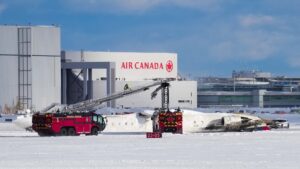Delta Air Lines Regional Jet Crashes at Toronto Pearson International Airport: What You Need to Know
On February 17, 2025, a stunning incident unfolded at Toronto Pearson International Airport when a Delta Air Lines regional jet crash-landed, injuring at least 15 individuals. The event not only sent shockwaves through the aviation community but raised concerns regarding airline safety and operational challenges faced in adverse weather conditions. At Extreme Investor Network, we dive deeper into this incident and its broader implications for the aviation industry.
Incident Overview
The Delta Flight 4819, operated by Endeavor, was nearing the end of its journey from Minneapolis-Saint Paul International Airport when the CRJ-900 regional jet encountered difficulties while landing. The plane, carrying 76 passengers and 4 crew members, crashed around 2:45 p.m. ET. Quick emergency response crews arrived on the scene, and thankfully, all onboard were evacuated. However, reports indicated that two passengers were airlifted in critical condition.
In light of the accident, Delta Air Lines announced the cancellation of its remaining flights to and from Toronto for the day and issued travel waivers to affected passengers. Delta’s CEO, Ed Bastian, expressed solidarity with those impacted by the incident, highlighting the devotion of the Delta and Endeavor teams, as well as the heroics of the first responders.
Weather Conditions: A Challenging Factor
The crash occurred under challenging weather conditions, with Toronto experiencing a severe snowstorm that dropped over 8 inches of snow and winds reported between 20 mph and 30 mph, reaching gusts of up to 40 mph. The Toronto airport had been expecting to accommodate around 130,000 travelers across approximately 1,000 flights, making this incident particularly disruptive.
At Extreme Investor Network, we urge our readers to consider the significant impact weather can have on aviation operations. As reported, the FAA and other aviation authorities like the Transportation Safety Board of Canada are closely examining how these factors contributed to this crash—a crucial part of ensuring that airports and airlines implement better safety measures in adverse conditions.
Investigative Actions Underway
The Transportation Safety Board of Canada is set to conduct a thorough investigation into the crash, aiming to unveil what went wrong and ensure that necessary safety protocols are reinforced. U.S. Transportation Secretary Sean Duffy noted that FAA investigators are on their way to assist in the inquiry, stressing the importance of collaboration between U.S. and Canadian aviation safety bodies.
This incident draws comparisons to the tragic midair collision at Reagan International Airport just weeks earlier, which resulted in the loss of all 64 lives on an American Airlines regional jet. These unfortunate events underscore the critical need for vigilance in air travel safety and the ongoing discussions around regulatory and operational improvements in the industry.
The Broader Impact on the Aviation Industry
While the immediate aftermath of the crash has sparked concerns for Delta Air Lines and passenger safety, it raises broader questions about the airline industry’s operational readiness in a rapidly evolving environment—especially one that is often impacted by inclement weather and other unforeseen challenges.
There have been recent layoffs within the FAA, prompted by administrative changes, creating a ripple effect in air traffic management. However, it’s important to highlight that the agency is actively hiring to ensure that they retain employees who perform critical safety functions. At Extreme Investor Network, we comprehend how such workforce dynamics impact overall aviation safety and efficiency.
Conclusion
As details continue to emerge regarding this harrowing incident, the Extreme Investor Network stands committed to bringing our readers timely insights and in-depth analysis. We aim to keep you informed not just about the facts but also provide context that empowers your understanding of the aviation landscape and inspires thoughtful discussions on airline safety practices moving forward.
In these challenging times for the aviation sector, it’s more important than ever to stay informed and prepared. Let’s continue to keep our thoughts with those affected by this tragic incident and ensure that we advocate for a safer future in air travel.

